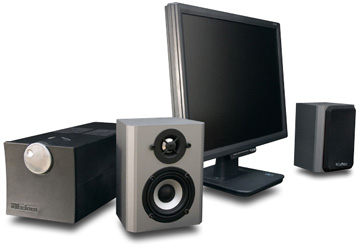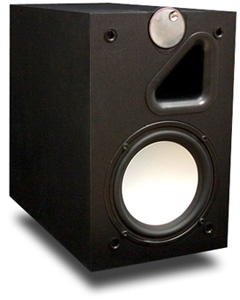Axiom Audio Audiobyte Computer Loudspeakers and
Amplifier and EPZero Subwoofer
 I haven’t been big on
what passes for audio these days. I sneer at MP3s, the antithesis of high fidelity. I
don’t own an iPod or any other such device, and don’t plan to. About the only
aural use I make of my computer is to listen to radio via the Internet (especially WBGO,
the jazz FM station from Newark, New Jersey), and most often, those services don’t
sound all that good. I haven’t been big on
what passes for audio these days. I sneer at MP3s, the antithesis of high fidelity. I
don’t own an iPod or any other such device, and don’t plan to. About the only
aural use I make of my computer is to listen to radio via the Internet (especially WBGO,
the jazz FM station from Newark, New Jersey), and most often, those services don’t
sound all that good.
So why am I so enamored of Axiom Audio’s Audiobyte
computer speaker with matching amplifier ($349 USD) and passive EPZero subwoofer ($179)?
Have they blown all my preconceptions into the weeds?
Description
The Axiom Audiobyte is tiny -- roughly 6.5"H x
5.5"W x 4"D -- with a 3" aluminum midrange driver, a 1" titanium
tweeter, and a claimed frequency response of 100Hz-20kHz. The EPZero passive subwoofer
isn’t huge either -- just 12.4"H x 7.9"W x 14.5"D, with two modest
6.5" drivers -- but it’s unique: on the front is a three-position switch that
controls the sub’s output level. The settings are Flat, Half Boost, and Full Boost;
no details are offered in Axiom’s literature, but there was a fair amount of
difference in bass output between Flat and Full Boost.
All three speakers are driven by the dedicated amplifier,
which measures 5"H x 5"W x 12.4"D. The amp’s only controls are a
volume knob on the front and a Power switch on the rear. The speakers are connected via
supplied cables terminated in 3.5mm phone plugs. The EPZero has its own dedicated output
on the amplifier, but there’s also a line-level subwoofer output if you plan to use a
different, active sub. The amp offers two inputs: a stereo 3.5mm phone jack (the system
includes a stereo-RCA-plug-pair-to-stereo-3.5mm-plug patch cord) and a USB input for an
iPod (it also charges the iPod). Axiom claims the amp puts out 55Wpc -- a lot more than
most computer-speaker setups. No other specs are provided.
System
My computer is far from the state of the art: a Dell
Dimension 8100 PC from late 2001, 1.8GHz Pentium 4 with 512MB RAM and a 40GB hard drive,
running Windows 2000. However, it does have a Turtle Beach soundcard, which several of my
audio-oriented IT friends told me was one of the best a couple years ago. (There are
doubtless better cards now, but the TB does me fine.) I drove the Axiom amp via its analog
input. The speakers were set up just in front of my widescreen monitor, about 15"
apart (from mid center to mid center).
Sound
 What all have I found in the process
of trying out the system by accessing the Web? I’ve been "RickRolled" --
sent without my understanding to a YouTube video of Rick Astley’s 1987 hit,
"Never Gonna Give You Up." Of course, the joke is on the perps -- I actually like
the song. It sounded quite good through the Audiobyte-EPZero system, especially when I set
the sub’s bass control to Full Boost. I’ve searched YouTube for songs by such
favorite artists as Aretha Franklin (good versions of "Think"), Manhattan
Transfer (their version of "Birdland" with Weather Report is a train wreck but
interesting), and Lambert, Hendricks & Ross (they sing "Cloudburst" on the
set of Playboy After Dark, a syndicated TV series from the early 1960s -- yes,
that’s Hugh Hefner on the couch, puffing on his pipe and flanked by two rather
pneumatic lovelies). What all have I found in the process
of trying out the system by accessing the Web? I’ve been "RickRolled" --
sent without my understanding to a YouTube video of Rick Astley’s 1987 hit,
"Never Gonna Give You Up." Of course, the joke is on the perps -- I actually like
the song. It sounded quite good through the Audiobyte-EPZero system, especially when I set
the sub’s bass control to Full Boost. I’ve searched YouTube for songs by such
favorite artists as Aretha Franklin (good versions of "Think"), Manhattan
Transfer (their version of "Birdland" with Weather Report is a train wreck but
interesting), and Lambert, Hendricks & Ross (they sing "Cloudburst" on the
set of Playboy After Dark, a syndicated TV series from the early 1960s -- yes,
that’s Hugh Hefner on the couch, puffing on his pipe and flanked by two rather
pneumatic lovelies).
When I began my serious listening, I wanted to see how the
Audiobyte system would handle intense, percussive music. These characteristics were well
demonstrated by Fourplay’s "Bali Run," from their eponymous debut album
[CD, Warner Bros. 26656-2], which has highs, lows, and everything in between, all in
abundance. The Audiobytes handled it all with aplomb. The initial guitar is delicate, but
the bass that enters soon after is deep-footed and athletic, even with the sub’s
control set to Flat; at Half or Full Boost, the bass output with this track was a bit over
the top. The brushes had just the right degree of air through the Audiobytes and the
soundstage was full, despite how close together I’d placed the speakers. They wanted
me to sit about 2’ back for the clearest sound. All in all, it was impressive sound,
and amp and speakers worked well together: there was no sense of strain as they reproduced
this tune.
The Audiobyte system did a fairly nice job on "Our
Love Is Here to Stay," as performed by John Pizzarelli and the Don Sebesky Big Band
[CD, RCA 67501-2]. My one quibble was that the satellites added a little lower-midrange
tubbiness to Pizzarelli’s voice. There also was a discernible disconnect in the bass:
the harmonics came from the satellites, while the fundamentals came from the sub about
3’ away. Not bad, but not perfect. The big band’s horns came through
beautifully, even the baritone sax.
The guitar that opens Diana Krall’s lush version of
"Let’s Face the Music and Dance," from her When I Look Into Your Eyes
[CD, Verve IMPD-304], was well reproduced by the Audiobyte system. Again, the speakers set
up a very fine soundstage, with Krall’s voice a bit out in front of her piano and the
rest of the instruments behind that -- though not too far; this is a pretty
intimate-sounding recording, given the large number of players. I was never really tempted
to change the sub’s setting from Flat, though I did try the other settings -- only to
find the bass too prominent, as expected. The light percussion also was reproduced well,
with just the right presence.
There is a lot of percussion in the accompaniment to
Manhattan Transfer’s vocal performance of "Birdland" on their The
Definitive Pop Collection [CD, Atlantic/Rhino R2 74111]: synth drums and bass galore!
The Audiobytes provided some good punch -- there was nothing sloppy about their
reproduction. Interestingly, the kick drum was above and to the right of center stage, but
well back from the singers. Tim Hauser’s baritone had a bit of the tubbiness I heard
in Pizzarelli’s voice, though, oddly, not as much (Pizzarelli’s voice is higher
in timbre and lighter in tone). Furthermore, the source of this seemed to be an
interaction in the sub’s output of Hauser’s voice and the kick drum. It was
nothing too disturbing; it just fell a bit shy of perfection.
Conclusion
Axiom Audio’s Audiobyte-EPZero system offers marvelous
sound and an attractive appearance, and nearly everything I played through it sounded
fine. In fact, the Audiobytes are so much better than my own crummy little cheap-o
computer speakers that I now realize I may have been missing the computer-audio boat. For
one thing, thanks to the EPZero sub, the Audiobyte system has some real bass. For another,
the Audiobyte has actual output above 5kHz. This little rig is a lot better than I
expected, and provided a fine glimpse of what is available from a really good hi-fi
system.
While the Axiom system has made me realize that
computer-based audio doesn’t have to sound crummy, its $578 price is a bit rich for
my blood. But if you use your computer to create music or video soundtracks, or to listen
to a lot of music downloads and/or watch movies, the Audiobyte-EPZero system could be just
the ticket. It sure exceeded my expectations.
. . . Thom Moon
Prices of equipment reviewed
|